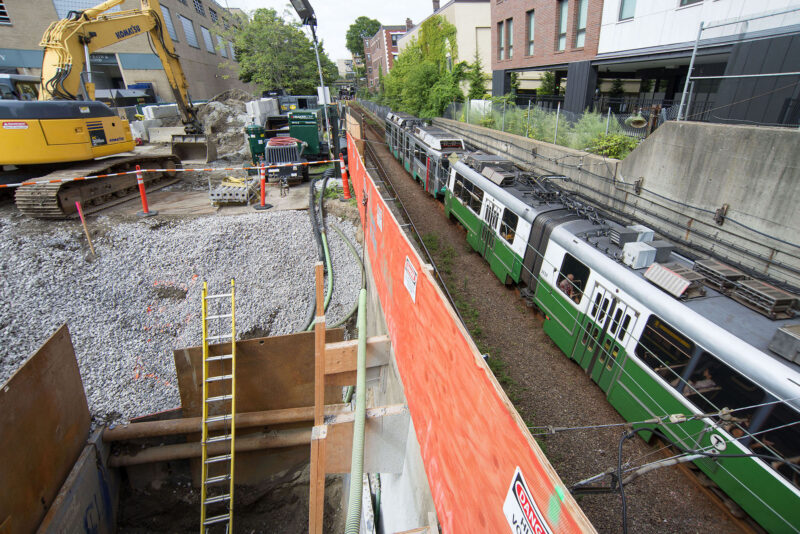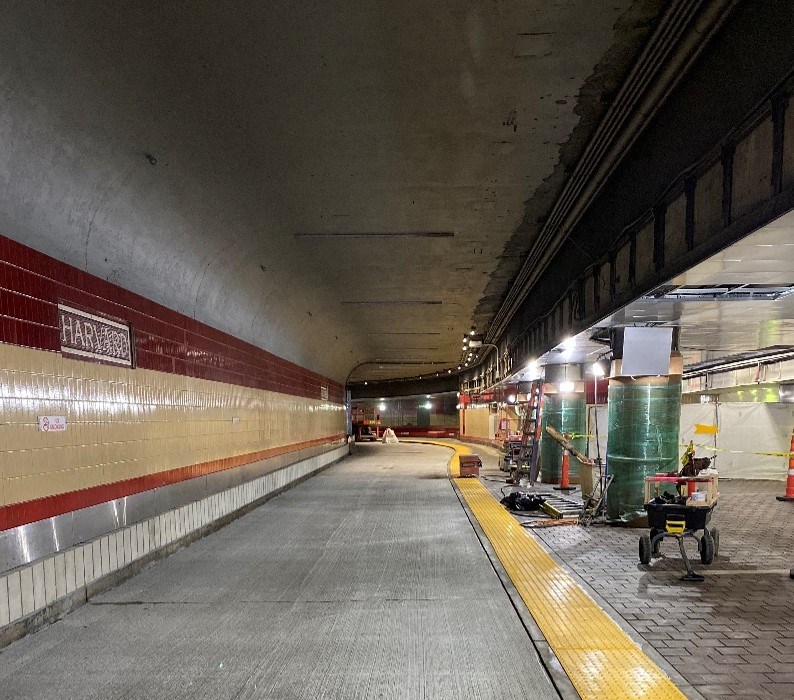
The Massachusetts Bay Transportation Authority (MBTA) is back on track with significant infrastructure investment and a clear vision for the future. The two capital projects – Building a Better T 2020 and the MassDOT 2020-2024 Capital Investment Plan will go a long way in making the system better, safer, and more reliable for the million-plus people who depend on it every day. This will not be easy, it never is, upgrading an outdated system can be a dicey proposition – but a very rewarding one, especially with a great team.
We speak from experience. BOND has been operating for more than 100 years, and for most of that time, we have been a trusted partner of the MBTA. We have key knowledge in:
- Emergency infrastructure and tunnel repairs
- Upgrading railroad signals including wayside signal house installations
- Flood mitigation
- Continuous welded rail
- Modifications to electrical substations and critical infrastructure
Since MBTA projects are complicated work, they need a construction management partner that understands the deep complexities that go into these intricate projects.
Challenges & Bold Solutions
When you work with an aging system, you are bound to run into unanticipated problems and the need to develop innovative solutions. Take our work in Fenway near Kenmore Station, which was washed out in 1998 by the overflowing Muddy River. Today, we are helping install flood gates and flood doors so the tunnel can be sealed off in case severe flooding ever happens again, but the project was derailed, so to speak, for a moment when it first began.
Anyone who has traveled on the Green Line knows the trains make turns underground. BOND Civil & Utility (BOND C&U) was tasked with installing flood doors into an old, curved section of tunnel. While the walls were strong enough to handle daily train traffic, they could not support the weight of the 20,000-pound flood doors that were supposed to be anchored into place.
So, we turned to our in-house Virtual Design & Construction Team to scan the existing infrastructure. Due to the alignment and elevation of the rails, the scan showed that we had to move the location of the doors and work with the engineer to reinforce the structure. The two pieces that were part of the contract for us to design also had to be changed resulting in the creation of a complete redesign based on our scans. We used Building Information Modeling (BIM) technologies to create a 3D CAD model of the tunnel which the flood door and retractable catenary arm manufacturers then used to create a 3D model of the entire system to make sure everything was going to operate as intended. With this model, we were able to perform clash detection and integrate it through several conditions. As a result, the Fenway Flood Doors project is now 80% complete.
This underscores our practice of analyzing plans and specifications to identify problems early in the project, allowing us to coordinate with everyone that is working on the project and propose informed solutions that will save time and money down the line.

MBTA, Fenway Portal Flood Mitigation Project, Boston
Coming Down the Tracks
The current five-year Capital Investment Plan includes more than $18 billion in transportation investments for both MassDOT and the MBTA—the largest amount to be spent on the Massachusetts transportation system over any recent five-year period, so BOND Civil & Utility and other contractors will be busy. We are preparing for transformer upgrades and associated containment systems for the light rail operations of the Red, Green, and Orange Lines. The goal of the project is to increase safety and reliability of the system and prevent downtime from power issues. Other upcoming work will include installing duct bank signal house foundations, switch upgrades, and new signal raceway to improve the signaling system in and out of North Station on the Commuter Rail; this will alleviate delays caused by a congested route.
Maximizing Schedules
Currently, we are working in Harvard Square finishing the Bus Tunnel Repair Project. This project required phased construction of two tunnels carrying buses under busy Harvard Square. Projects of this nature are designed utilizing phased construction to minimize the impact on the commuting public.
With coronavirus decreasing ridership, BOND Civil & Utility was able to partner with the MBTA to re-sequence the project. While we were not in an active construction phase when the pandemic hit, BOND Civil & Utility was well prepared with permitting, planning, and material procurement and were able to mobilize within a week, working with our trusted vendors and subcontractors to capitalize on reduced ridership to accelerate the schedule. This strategy mitigated potential delays to the job, ultimately improving the MBTA’s position on the project.
For both Fenway and Harvard Square projects the contract specifies BOND Civil & Utility’s working periods. Fenway requires track shutdowns from Saturday 1 a.m. to Monday 4 a.m. for 14 weekends. However, to date, we have worked a combination of early access weekends and during nine-day consecutive outages to improve the schedule. On the other hand, Harvard Square is comprised of a typical working period from June to December. The scope expanded so much during Phase 1, the MBTA added bus shutdowns for an additional nine months. BOND Civil & Utility is committed to working outside of the limitations of the initial contract to benefit the stakeholders with a new accelerated schedule.

MBTA, Harvard Square Bus Tunnel Repair Project, Cambridge, MA
The Real Product
Most important to us is the customer experience – this is really the end product here. You can have the cleanest stations in the world, but if on-time performance is unreliable and customers do not know if their commute will take 20 minutes or two hours, it is all for naught. We strive to make sure that the work we do is reliable and top notch.
This comes down to the character of our crews, the cleanliness of our sites, even the signage to help passengers know where to catch a bus or navigate their way around our work. It is being mindful every day to make sure each passenger is just as happy with our work as the professionals from the MBTA are happy.
Again, take a look at our recent work at the Harvard Square bus tunnels. The tunnels were deteriorated more than most people realized and this meant that our scope of work expanded. Yet, we still were able to maintain milestone dates and limit unnecessary shutdowns. When the upper busway reopened in December 2019, passengers actually clapped because they were grateful for the work that had been completed, providing our team with the satisfaction of a job well done.
Shaving a few minutes off a commute may not seem like much, but when you consider it over the course of a 10 or 20-year career, it adds up to a substantial amount of recaptured time, and in today’s busy world, every additional moment with family and friends counts.
The MBTA is certainly looking to maintain its position as a world-class system and we try to deliver this level of quality every day with our knowledge and experience. BOND Civil & Utility is pleased to see passengers get to where they need to go, when they need to be there, and we are proud of our role in helping keep everything on track.


